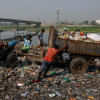Fears over unauthorised Everest flights

Helicopter firms are carrying out unauthorised sightseeing flights over the upper reaches of Mount Everest, Nepalese officials say.
Sherpas have expressed concerns that vibrations caused by the helicopters could trigger avalanches.
Tourist flights are not allowed to places above Base Camp which is at an altitude of 5,364 metres (17,600ft).
But helicopter companies say they only overfly sights like the Khumbu Icefall and their flights are allowed.
There had been no expedition on Everest for the past two years because of a series of disasters.
Sixteen Sherpas died on their way to Camp One in an icefall in 2014. At least 18 climbers died at Base Camp after a major earthquake triggered a huge avalanche last year.
After the 2014 disaster, authorities moved the climbing route to the middle of the Khumbu Icefall.
It is a treacherous section that mountaineers must cross on their way up to the summit of Everest.
Climbing Season
Sherpas are currently transporting expedition equipment to higher camps for the current climbing season.
"The sightseeing helicopters are hovering above the Khumbu Icefall and making things difficult for us," said Pasang Kaji Sherpa, a mountain guide with a military expedition team now on Everest.
"We worry that the vibrations caused by helicopters can crack ice blocks and snow packs on mountains overlooking the Khumbu Icefall.
"There is a deep-seated fear among Sherpa porters that they may be hit by avalanches this year as well and these helicopters are increasing fears," Pasang Kaji Sherpa added.
After the BBC started to investigate whether sightseeing helicopters were permitted to fly to places like the Khumbu Icefall, the Civil Aviation Authority of Nepal (CAAN) issued a circular to all airlines warning them not to conduct such flights.
"We have made it clear in the circular that sightseeing flights are simply not allowed in places higher than the base camp," said Rajan Pokhrel, Deputy Director General of CAAN.
"Only rescue flights during emergencies are allowed in those areas and sometimes we allow special projects like skydiving when recommended by other government authorities."
Pokhrel said his office had also heard the Sherpas' concerns.
Airline Defence
However, airline officials say there is no such danger.
"We fly 2,340 feet from above the ground and maintain at least 1km distance from the mountains so there is no way the vibration can cause avalanche," said Pabitra Karki, chairman of Airlines Operators Association Nepal (AOAN).
"We use the French-made Ecureil helicopters for sightseeing which are very light and we carry two to three passengers in each flight."
AOAN officials say there are around half a dozen sightseeing flights per week during the climbing season.
But other sources at Base Camp said such flights were becoming more frequent.

 For all latest news, follow The Daily Star's Google News channel.
For all latest news, follow The Daily Star's Google News channel. 








Comments